I love antique doorknobs. They’re fun to collect, easy to install, and (if you’re using them on your doors), the collection takes up no space and can be enjoyed every day. They come in all price ranges, from about $5 per knob to over $800 for some of the rarer ones. And while they’re not seen in every antique shop, they’re easy to find if you know where to look (hello, Preservation Station!). They’re a breeze to install, even on a modern door. And to prove it, I’m going to step you through the process.
 This is an antique glass knob set as you will usually find it. Occasionally you will find knobs without the rod connecting them; this piece is easily replaced.
This is an antique glass knob set as you will usually find it. Occasionally you will find knobs without the rod connecting them; this piece is easily replaced.
 As you can see in the picture, glass knobs take the threaded type of rod that screws into the base of each knob. Each knob is held in place by a set screw, pictured here.
As you can see in the picture, glass knobs take the threaded type of rod that screws into the base of each knob. Each knob is held in place by a set screw, pictured here.
 To remove a knob from the rod, loosen the set screw. it’s unnecessary to remove it entirely on this type of knob — just loosen it until…..
To remove a knob from the rod, loosen the set screw. it’s unnecessary to remove it entirely on this type of knob — just loosen it until…..
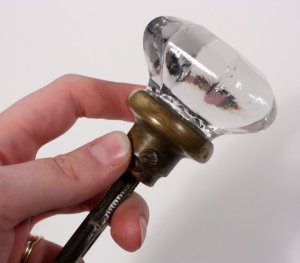 ….you are able to easily unscrew the knob. Unscrew the knob from the rod. Occasionally, the rod can rust into the knob, in which case you can use pliers to get a better grip on the rod. When removing a knob, it’s best to turn it by the brass section to avoid damaging the knob.
….you are able to easily unscrew the knob. Unscrew the knob from the rod. Occasionally, the rod can rust into the knob, in which case you can use pliers to get a better grip on the rod. When removing a knob, it’s best to turn it by the brass section to avoid damaging the knob.
 Congratulations! You’ve removed the knob and are ready for installation.
Congratulations! You’ve removed the knob and are ready for installation.
 This is another common type of rod, generally found on metal and porcelain doorknobs.
This is another common type of rod, generally found on metal and porcelain doorknobs.
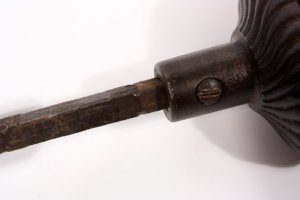 Most metal and porcelain knobs take an unthreaded rod like this one.
Most metal and porcelain knobs take an unthreaded rod like this one.
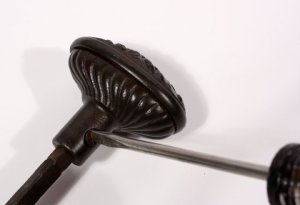 To remove a knob from this type of rod, you will need to remove the set screw completely.
To remove a knob from this type of rod, you will need to remove the set screw completely.
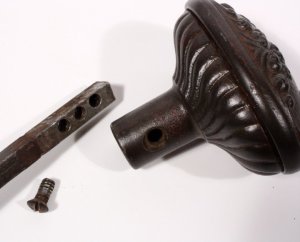 Once the set screw is removed, the knob will slide off the end of the rod.
Once the set screw is removed, the knob will slide off the end of the rod.
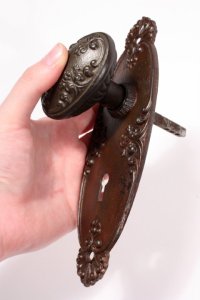 Put your knob through one plate, in preparation for passing it through your door.
Put your knob through one plate, in preparation for passing it through your door.
To adjust this rod for different doors, the rod has several holes on each end. Depending on your door thickness, you may need to adjust which hole the set screw goes into.
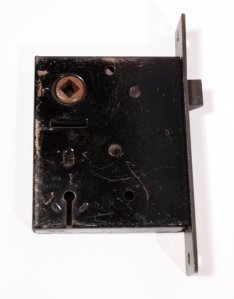 Most antique doors take a mortise lock (pictured) that slides into an opening in the edge of the door. Once a mortise lock is installed, only the edge is visible.
Most antique doors take a mortise lock (pictured) that slides into an opening in the edge of the door. Once a mortise lock is installed, only the edge is visible.
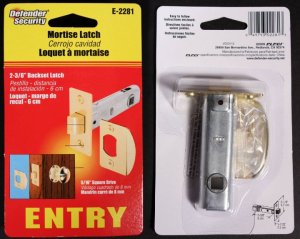 For modern doors, you can use this special mortise latch. It’s the same size as a regular latch, but has a square hole in it so that you can use it with antique knobs. (I’m about to buy several of these so I can take my antique knobs to our new apartment. I just can’t take modern doorknobs. Yes, I know I have issues.)
For modern doors, you can use this special mortise latch. It’s the same size as a regular latch, but has a square hole in it so that you can use it with antique knobs. (I’m about to buy several of these so I can take my antique knobs to our new apartment. I just can’t take modern doorknobs. Yes, I know I have issues.)
 This is what the door will look like with the mortise lock in place, before you add the plates and knobs. Most interior doors have a standard distance between the knob and the keyhole (on exterior doors, they are often spaced farther apart).
This is what the door will look like with the mortise lock in place, before you add the plates and knobs. Most interior doors have a standard distance between the knob and the keyhole (on exterior doors, they are often spaced farther apart).
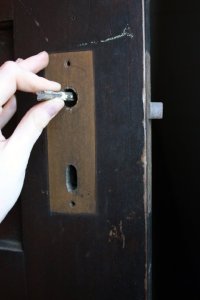 To install the knob set, take the rod, with the single knob and plate, and pass it from one side of the door to the other (the knob and plate are on the other side of the door).
To install the knob set, take the rod, with the single knob and plate, and pass it from one side of the door to the other (the knob and plate are on the other side of the door).
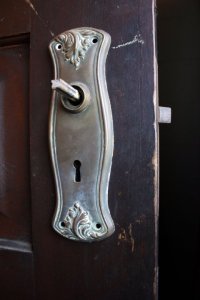 Add a plate. You will screw the plate in after the knob is installed.
Add a plate. You will screw the plate in after the knob is installed.
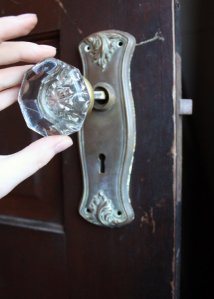 Take your knob and screw it onto the rod until it rests in the furl of the plate (or, if you’re using the other type of doorknob, slide it on). Once your knob is adjusted satisfactorily, tighten the set screw.
Take your knob and screw it onto the rod until it rests in the furl of the plate (or, if you’re using the other type of doorknob, slide it on). Once your knob is adjusted satisfactorily, tighten the set screw.
 You have successfully installed your antique doorknobs! To finish, fasten each plate to the door with small screws.
You have successfully installed your antique doorknobs! To finish, fasten each plate to the door with small screws.
See, wasn’t that easy? So today, the Daring Domestic challenges you to go find a cool antique doorknob set and install it in your home.


Charity,
Is it truly this easy? I am wanting to get vintage door knobs and put them in our entry closet doors. They are standard, modern doors. Does the way you describe above really work? If I buy a set off ebay what do I need to make sure is included? I would love anything you have to offer in reply. This addition would add such simple, amazing character to our place. The other articles I read on line made it seem soooo expensive and hard.
Thank you,
brea
Hi Brea,
Yes, it really is a piece of cake. It takes me about 10 minutes to install a set in my 1980’s apartment. You’ll need a pair of antique knobs, a pair of backplates at least 2 1/8″ wide (go for 2 1/2″ if you can, to be completely safe), and a little modern latch adapter like the one pictured (which we have at http://www.thepreservationstation.com). If you’re looking for hardware, you’re always welcome to call me at work at 615.292.3595 (Tues. – Sat.). We have a really good selection of hardware at the shop; but if you’d like to buy a knob set off eBay, you can always just call and order the adapter latch from us.
Charity
Hi what if your doors have a large 3″hole behind the knobs like most modern door today?
Hi Kat,
A couple people have asked about that — there’s some info in the previous comments. If you have any other questions, please let me know! 🙂
Charity
I was wondering do you have a picture of the adaptor latch I would love to install glass knobs but I have modern doors with predrill holes someone told me they are to big use the glass knobs 😦 thank you for you post.
Here’s a link to the one that my former employers sell. http://www.thepreservationstation.com/antique-hardware/antique-locks-latches/modern-mortise-latch-set-for-antique-knobs-2-3-8-backset-5-16-square-drive-oil-rubbed-bronze.html You would need one of these and a pair of door plates that are large enough to cover the hole.
Yes it is really that easy! Just bought some old door knobs from my new favorite Architectural Antique shop and replaced two knobs in about 20 minutes. Can’t wait to change more.
Thanks, Matt! Watch out, though — antique doorknobs are addictive and it’s hard to stop once you’ve started. 🙂 It was nice to see you again today — have a Merry Christmas!
Yes, if the modern door is already prepped for a conventional lockset this should be no problem so long as the antique outside plate completely covers the 2 1/8 (modern hole) (some don’t/won’t) If you’re doing this “from scratch” with an un-prepped door you’ll need a drill, tools, and a little know-how. I’ve done this a few thousand times though not with a back-set like you’ve shown above for the square knob shaft which wouldn’t require the 21/8″ (modern) hole. If the old-type mortise lock is to be installed, that is a far more involved process, one only performed these days on “high-end” applications/homes.
Does this mortise lock that preservation station sells lock? I would like to do this to our bedroom and bathroom doors, but need to make sure they will lock!
Hi Janae,
They do lock — some with a skeleton key and some with a thumb turn (the basic ones listed on the website don’t include the keys, though, since the keys usually are no longer with the locks). I’d recommend calling and letting them know whether you’d like a key or a thumb turn. Hope this helps!
Charity
I was talking about the modern latches they sell that are compatible with vintage knobs like you have pictured above….do they lock? Just wanted to make sure we are on the same page:). Thanks!
Hi Janae,
Sorry for the delay in replying! My internet has been out for the last couple days. The modern latches don’t lock — but you can usually get a separate little lock to use with it that’s easy to install. I don’t know if there are any in stock right now (I left Preservation Station to go to grad school), but if you ask, they’ll be glad to help you out. Tell them that I sent you. 🙂
-Charity
I was hoping you would address the giant circular hole in modern doors that narrow vintage faceplates are not wide enough to cover. The door in your instructions is not a modern door.
Hi Dawn,
The only really easy solution for the modern door hole is to get a plate that is 2-1/8″ wide or larger (that’s what I did on all the modern doors in my house). Eastlake and Deco style plates are almost always too narrow, but the c. 1905 decorative plates and Arts and Crafts style plates are generally wide enough. The little modern latch I pictured works very well with those. If you have a narrow plate that you want to use, the only feasible solution is to fill the hole and start over drilling a new one. Hope this helps! If you have any other questions, let me know and I’ll be glad to help.
Charity
Hi Charity,
Just wondering where to find the larger round plates. I’ve checked ebay and they are almost all too small. I have existing hardware on the doors that I am replacing with antique crystal and the existing plates are about 3″ in diameter.
Thanks.
Sharon
Hi Sharon!
You probably won’t be able to find round ones that will cover it. The longer rectangular plates (which were commonly found on interior doors) are going to be a better option for you (they cover larger holes better and look cooler in general, really). You may want to take the hardware off of your door and see how large the hole actually is — go for covering that hole rather than necessarily matching the width of your existing hardware. Does that all make sense? Let me know if you have any other questions!
Charity
Charity,
Hello! We are wanting to replace modern doors-doorknobs with antique ones ….can you give me a step by step process and what materials will be needed?
Thanks Tandra
Hi Tandra,
The installation process for hardware is pictured in the blog post; installation for the door itself is much like any other door. If you’re planning to replace your doors AND your doorknobs all with antique, you’d need the following:
Door
Hinges (most antique doors had two; modern contractors typically recommend three). Size varies, but most door are mortised for 3.5″ or 4″ hinges.
A mortise lock (or a modern latch if you’re using a new door)
Two doorplates
One set of doorknobs with its connecting spindle and set screws
A strike plate (a.k.a. striker) for your door jamb, which matches the lock
A skeleton key, if you want one and/or if you can find one 🙂
Screws for everything – get your other hardware first, and then match the screw sizes to the hardware. Straight-slot looks best — and you can paint the heads to match your hardware. If you’re buying your hardware from someone, ask if they have screws to go with it to simplify matters. 🙂
I’m working on a book that will give more specifics and various troubleshooting advice — I’m hoping to finish it this summer. If you’re interested, let me know, and I can email you when I get it finished.
I hope this helps!
Charity
I know this is a really old post, but I really want to do this in my house, but need many of the doors to lock. What do I need for that?
Hi Tamara,
You’ve got three different options for that (at least three that I can think of). The most complicated one is to install an antique mortise lock with either a key or a thumb turn. The second option (easiest) is to get a little surface-mount slide bolt or even just a screen door type hook for the inside (a screen door hook is what my great-grandmother had on her nineteenth-century bathroom door for YEARS). The third option would be one of these things: http://www.vandykes.com/mortise-door-bolt/p/205209/, which should be easy to install with just a drill. I hope this helps, and do let me know how it turns out!
Charity
I followed all these steps w my old crystal door knob. But it’s just now turning very smoothly.. I’ve tried everythg.. Tightening, loosening PLEASE HELP!
I followed all these steps w my old crystal door knob. But it’s just NOT turning very smoothly and feels like it geths stuck.. I’ve tried everythg.. Tightening, loosening PLEASE HELP!
Hi Caroline,
I’m guessing that it’s one of two problems: Either the shank on the knob is too big for your plate/rosette, or there’s a problem with the mortise lock (if you’re using an antique mortise lock). To check the plate, just make sure the knob turns easily in the collar (without having the spindle through the door).
If it’s the mortise lock, then there are three things I can think of:
1. It might need to be oiled (easy fix).
2. The plate on the mortise lock might be screwed on too tight (to fix that, remove the mortise lock and slightly loosen the screw that’s on the middle of the box).
3. Most likely, the spring in the lock is getting worn out. You may be able to find a locksmith to replace the spring; if not, you’ll need to get a new lock (I personally recommend Preservation Station, my wonderful former employers — they’ll be great at helping with that).
I hope this helps! Please let me know how it turns out and which (if any) of these solutions helped!
Charity
i have old fashioned doors that the previous owners (sob) crudely cut 2-1/8 inch holes in in order to install cheap, ugly modern knobs. I’m trying to replace them all with old knobs and plates, but the plates i’m dead set on using are just sliiiiiiightly too narrow (about 1/8th or 1/16th on each side). So even though it installed perfectly, there are still sad little gaps on each side. Is there someway i could patch these holes in a secure/non-flimsy way before screwing down the plates? or will i have to cut and drill holes in a bunch of 2-1/8″ circles myself and paint over it all? I’ve seen rejuvenation sells these weird bore inserts but at $18 a pop i feel like there must be a better alternative out there. I got a lot of doors to save!
Aww, don’t you just hate it when people do that! I recommend either filling it with Bondo and redrilling it; or I believe one of my contractor friends told me that a 2×4 is the same thickness, and he usually cuts out a 2-1/8″ circle to fill the hole. Now, I haven’t had any occasion yet to use either of these methods myself, but I know that others have had success with both routes. Please let me know what you end up doing! And I’d love to see photos of the finished product!
Hi Charity!
I have some of these antique otogon glass knobs and some of them are turning within the base as if they were not attached to it (but they are). I hope it’s clear… Do you know how ti fix that?
Thanks for your help!
Hi Nick!
Unfortunately, there’s really nothing that can be done for those (at least to my knowledge). They can be glued, etc., to keep them going for a while longer, but it won’t hold up long-term. I would recommend that you either replace them, or take the broken ones and put them places that they won’t be used much (i.e., on the inside of a closet door or on doors that are rarely closed).
If you do replace them, take the good ones and put them together in pairs, because it’s MUCH easier to replace a set of glass doorknobs than it is to replace just one. The threading is not standard on those, so it can be very difficult to find one that will fit an existing spindle.
Hope this helps!
Charity
Thank you Charity. I will try to find vintage ones on eBay or antique stores.
I also have another question: I live in a 1926 cottage in south florida made of dade county pine. I have these original inside doors which have been (unfortunately) painted over and over in horrible colors. I tried to sand it with different product from home depot but it’s not perfect nor easy. Is there a product or mixture you would recommend to get a beautiful result? If you can email me we could discuss about that.
Hi again Nick!
Wood finishing isn’t my area of expertise, but I can tell you that sanding will not get a good result. Sanding will wear down the edges on the door panels (and is just a royal pain). You will want to use paint stripper instead — I think liquid paint stripper is best (I have not worked with it myself, but this is what I know from talking to lots and lots of people about it). This is probably something that would be worth having done professionally — the guys I know in Nashville typically charge around $100 to strip a door.
If you have trouble finding knobs, then talk to Julia and Jack at http://www.thepreservationstation.com or 615-292-3595. I used to work for them, and they’re great people with a marvelous hardware selection. All their glass knobs have been checked to make sure they’re not “clickers.” 🙂 You can find knobs on ebay, too, but they’re often loose in the settings like yours, so you will definitely want to ask about that before buying any. You’ll also want to be aware the backs of the knobs are different sizes, so measure those before buying anything.
Paint stripper is good for hardware too — if your hinges are painted over, you can drop them in a bucket of stripper to improve them. 🙂
Feel free to comment with any other questions — this is fun, and I miss working with old houses! — or you can email me at charityeverett gmail . com. Would love to see some pics of your house — it sounds really cool!
Charity
Charity,, I have some beautiful antique door knobs completely intact with all the original hardware. My husband got these out of an old Victorian home in New England and he’s been carrying them around with him from state to state the last 30 years. I’m so glad I found your site because I’ve been wanting to install these in my home. I’m definitely going get them out of the box, clean them and see about installing them. I’ve become quite the handy woman these past few years. I’ve repaired my own appliances and my ac. I’ve learned how to install tile and wood flooring, the siding on the house, refinished my front door and completed all the exterior trim on my windows. So, I am confident I can install these knobs too.
That’s so exciting! Would love to see pics when you get them finished!! High five, for women with tools!
Hi Charity,
I purchased a 1910 home and all of the doors have original door knobs but I can’t seem to locate the keys for them. Could I just replace the locking mechanism as the knobs are all glass and in really good shape.
Thanks,
Monique
Yes, you could do that. Your best bet, though, might be to take one of your locks to a locksmith who specializes in skeleton keys.
Or take a lock to a flea market or somewhere where you could try out some different skeleton keys until you find one that fits? I would save replacing all the locks as a last resort, probably.
Well, I put the crystal knobs in but when I tighten them to the doors firmly, then the catch moves and it won’t stay in place – if the plates are tight to the door, the catch part doesn’t work. If I loosen the knobs, the catch works, but I can’t leave the knobs like that. Does this make sense? Any suggestions? Thank you
Yep, your problem is that you need to affix the plates to the door with screws and make sure the knob is loose enough to allow the catch to spring back out. The knob should not be what is holding the plates in place. Does that make sense?
Hello! So, my 1913 DC row house has the same door plates as in this article — the second set, with the glass knobs — and I am trying to figure out the manufacturer! The mortise locks were made by Corbin but I don’t see a mark on the plates. Any guidance or info you can share? (also, we have the original matching knobs, too!)
Thanks much!
Dave
Usually, things were sold as a set. Multiple companies made very similar glass doorknobs. If your locks are Corbin and your hardware is all original, it’s a safe bet that it all is.
I’m using threaded rods without holes and cannot keep the knob set screws from loosening. Any remedy?
Thanks, Willis
I’ve seen some threaded rods with an indentation to help secure the set screw. This is a little beyond my metal-working level, but I wonder if you could mark where the knob needs to be and then drill just a tiny bit into the rod to help lock the screw in place.
What about when the doorknobs keep coming off in your hand? I’ve tightened them as much as I can and they don’t stay on!
Hi Gina,
That means that the threads are stripped on the knobs, and they will need to be replaced. Alternately, you can drill the spindles for a different type of set screw, but that’s wobbly and I don’t recommend it. Preservation Station sells glass knobs — I haven’t worked there in years, but they’re wonderful people and have great hardware.
Is there a way to lock the antique door knobs on the faceplates for interior doors? The skeleton key doesn’t seem practical as it could easily get lost. I suppose a separate lock or latch could be installed.
Yes, you can either get a special mortise lock with a thumb-turn (used originally sometimes for bathrooms and therefore hard to find compared to regular ones) or install a separate lock (which is what my great-grandmother used in her bathroom!).
I purchased an old knob online with the rod in the back. I assumed a screw would be holding it in but there’s no screw and it’s stuck. Does one of the knobs of the set have the rod stuck in it? Is there a simple way to take it out/unstick it if not? Thanks!
They’re not *supposed* to be stuck, but that doesn’t mean that it doesn’t happen. If they’re glass knobs, your options are limited. If they’re steel knobs, you may be able to use heat to help unstick it. I hope this helps!
Thanks!
Hey, thanks for this great post and your helpful and continual replies to comment. Lots of good ideas and knowledge in there. We are tearing down our 1928 house (please don’t judge, we can’t afford to restore every part due to the major mold, termite, and foundation issues, got bids, unrealistic for our life and timeline, and it’s not actually historical due to the awful renovations of decades past, so down it comes). I desperately want to keep as many parts as we can and install them in the new house. The old, mismatched, wonky mortise locksets and glass knobs are a big part to me, and this will totally help me do that with less hassle. Currently we joke that every door (except the bathroom door, thankfully) frequently functions as a “wall” from time to time – they get stuck tight depending on the weather. Anyhow, we love the knobs, but want doors that always work like, well, doors! So thanks for this great post!
So glad it helped! You can use your doors in new construction, too. 😉
I have a glass antique doorknob where on 1 side the glass part has separated completely away from the backing that attaches it to the knob itself. How do I reattach the glass part only back to the knob because I can’t seem to get it to stick with any glue I’ve tried?
Thank you,
Maria
Hi Maria,
Unfortunately, your only viable option that I know of is to replace the doorknob. I no longer work for Preservation Station (I left, went to grad school, now working as a professor!), but I would recommend contacting them. http://www.thepreservationstation.com
Charity